Camdeboo National Park is best known for Desolation Valley with its panoramic viewpoints where tall columns of volcanic rock tower up to 120 m high over the plains of Camdeboo below. The aridity of the region gave rise to the name Desolation Valley. It is even more desolate now in the current drought emergency.
Camdeboo National Park incorporates the Nqweba Dam, which usually provides nearby Graaff-Reinet with water, but over the past few months the dam and its feeder rivers have dried up completely. On our recent stay in the park’s small tented camp we were privileged to have borehole water on tap – a luxury not currently available to many residents of Graaff-Reinet itself.
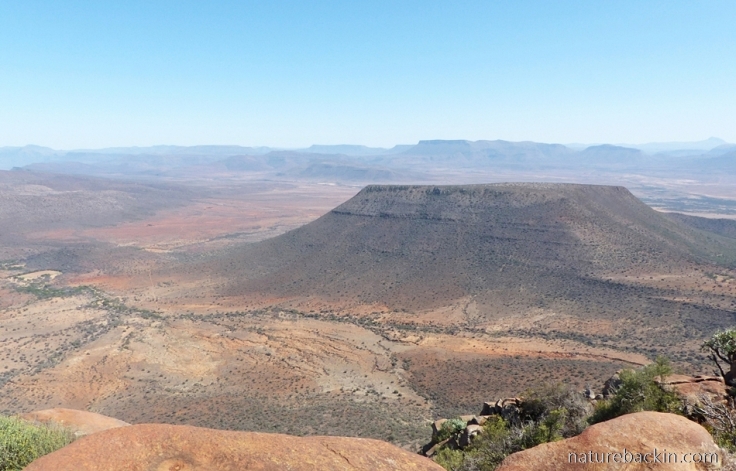
This view from the Crag Lizard Trail in the western section of Camdeboo National Park, looking towards the distant Sneeuberg range, gives some idea of the dryness
I have written about the ongoing drought in previous posts. The Karoo region is no stranger to drought, after all it is an arid, semi-desert region – the origin of the name Karoo is the Khoi-khoi word meaning “great thirstland”. However, the current drought is extreme even by the standards of the Karoo. At the end of October 2019, the Eastern Cape region was officially declared to be a “drought disaster area”.

This panoramic view (taken by my husband) illustrates that the name “Valley of Desolation” is even more apt now after four years of extreme drought

This viewpoint on the Crag Lizard Trail at Desolation Valley provides a clear view of the dry plains of Camdeboo below. Dark green lines of sweet thorn trees (Vachellia karroo – formerly Acacia karroo) mark the river beds and water courses that are all currently dry

Another view, with the weathered towers of volcanic rock in the foreground
In the eastern part of the park (to the north of the now dry Nqweba Dam), the small network of tourist roads enables visitors to see the dryness in close-up. The only green is provided by the sweet thorn trees and in some areas, the succulent spekboom. The name Camdeboo derives from a Khoi-khoi word (Xamdeboo), which means ‘green valley’, with the description ‘green’ thought to refer to these plants, which are relatively green even during times of drought.
In Camdeboo National Park, animals have access to water due to windmill pumps supplying borehole water to several small artificial watering points, but during the extreme drought animals have to stray from their usual areas in an effort to find food.
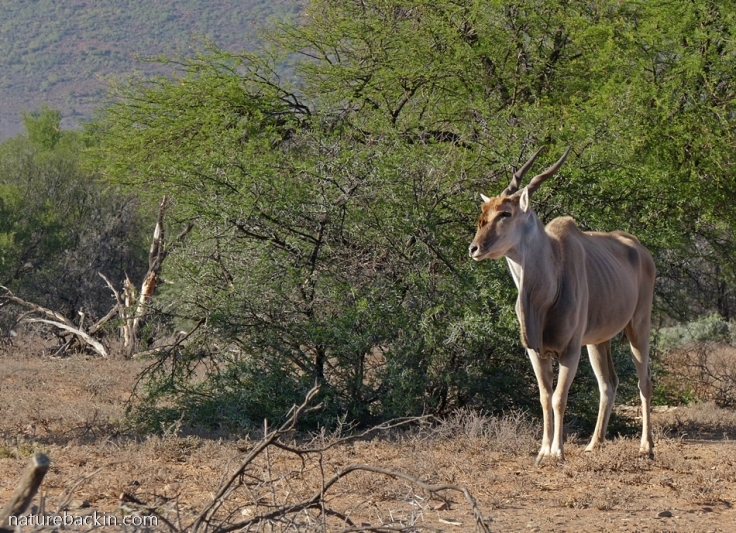
An Eland – its prominent ribs showing how thin it is – slowly approaches one of the artificial watering points in the Camdeboo National Park. As it seemed hesitant in our presence, we drove off to give it a chance to drink in peace

A suricate (meerkat) scraping the ground as it looks for insects and other prey. Usually we see suricates feeding in groups, so we were surprised to see this one apparently on its own. Perhaps, when times are hard, the animals are forced to spread out as they search for food
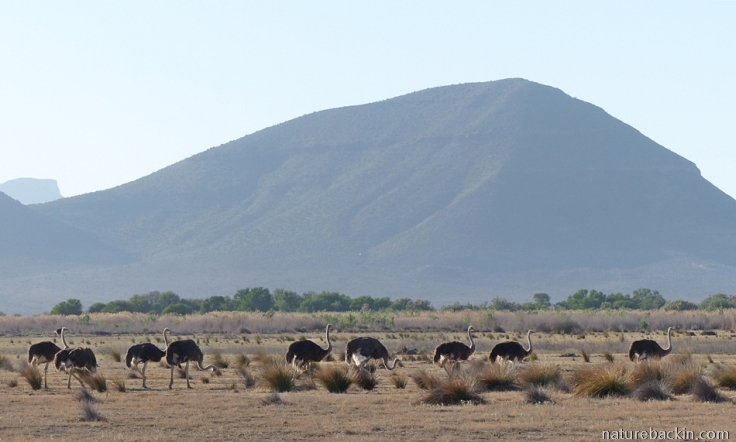
Wild ostriches foraging on what used to be under water when the Nqweba Dam was full. This part of the dam has been dry for so long that vegetation is now growing here
The Nqweba Dam has been slowly decreasing in size for a number of years, finally drying up completely in September 2019. It should be the main source of water for Graaff-Reinet, but now that the dam is dry the town is dependent on borehole water and water that is trucked in. The reception desk at Camdeboo National Park serves as a depot where travellers, passing through from areas that have water, may stop to drop off donations of bottled water for distribution to people in neighbouring communities who are trying to survive without piped water.
I came across an article in Business Insider South Africa that has two satellite images of the Nqweba Dam – one taken in June 2009, the other in September 2019. The two photos are overlaid, and by using a slider one is able to scroll across so as to compare the dam water level in 2009 to the dam having no water at all in 2019. To view this (literally) graphic depiction of the dam, see here

One afternoon we visited the bird hide on the dry shore of the Nqweba Dam, which is now completely devoid of any water. As this part of the dam has been dry for a long time, grasses and other plants have established themselves on what was the bed of the dam
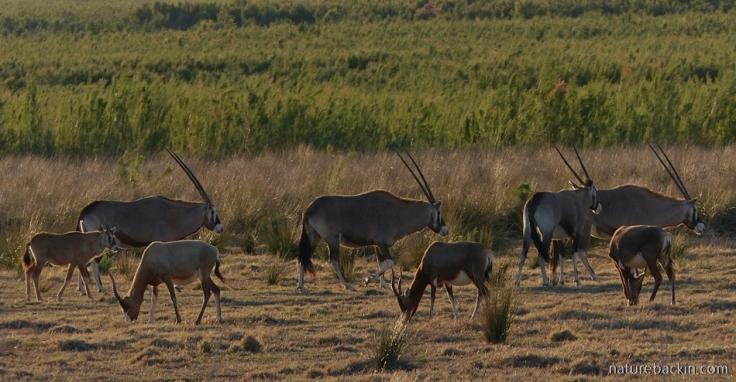
Seen from the bird hide, backlit by the afternoon sun gemsbok walk in line (see the youngster on the left) and blesbok graze in the foreground. The green vegetation behind is a highly invasive alien species of tamarisk, probably pink tamarisk (Tamarix ramosissima), a plant originally from the Ukraine region, which unfortunately has become naturalised in parts of the Karoo

We were fortunate enough to see a small group of Cape mountain zebras
Cape mountain zebras (Equus zebra zebra) have been pulled back from the brink of extinction. In the early 20th century, as a result of excessive hunting and habitat loss, there were less than 60 individuals left in the wild. Three relict (remnant) populations remained, namely, in the Cradock district and in the Kammanassie and Gamka mountains. Concerted conservation programmes were put in place, and over time the numbers have increased significantly.
According to the most recent assessment by the International Union for Conservation of Nature (IUCN), dated 1 December 2015, there were estimated to be between 2,381 and 3,247 mature individuals in both formally protected areas and on private land. (This number reduces if only populations greater than 50 individuals are taken into account.) One of the reasons for the increase (and the continuing increase) in numbers is the expansion of protected land areas and conservation programmes. Cape mountain zebras were classed as Endangered in IUCN Red List assessments from 1986 to 1996, and were downlisted to the status Vulnerable in the 2008 assessment. Taking a complexity of factors into account, the status of Cape mountain zebras was further downlisted as Least Concern in the Red List assessment published in 2019. For more details on the IUCN’s assessment of the Cape mountain zebra see https://www.iucnredlist.org/species/7959/45171853

Distinguishing features of the Cape mountain zebra include the slight dewlap on the underside of the neck, broad black stripes, stripes that continue right down the legs to the hooves, and stripes that do not extend under the belly so that the underside is white

The better known plains zebra (Equus quagga, formerly Equus burchelli) has shadow stripes, especially on the hindquarters, the stripes continue partway under the belly and the stripes fade out on the legs. The above photo was taken at Mkuzi Game Reserve in KwaZulu-Natal

The Cape mountain zebras we saw at Camdeboo stopped to watch us with what appeared to be considerable interest
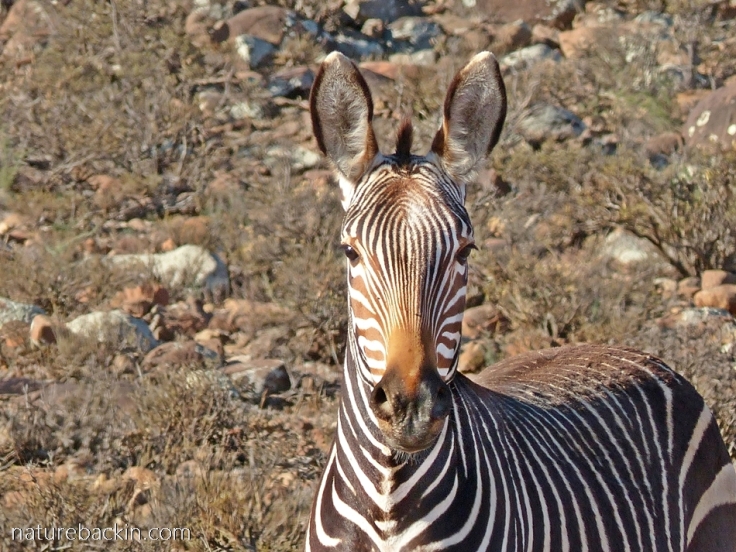
A portrait of a Cape mountain zebra, taken in late afternoon light
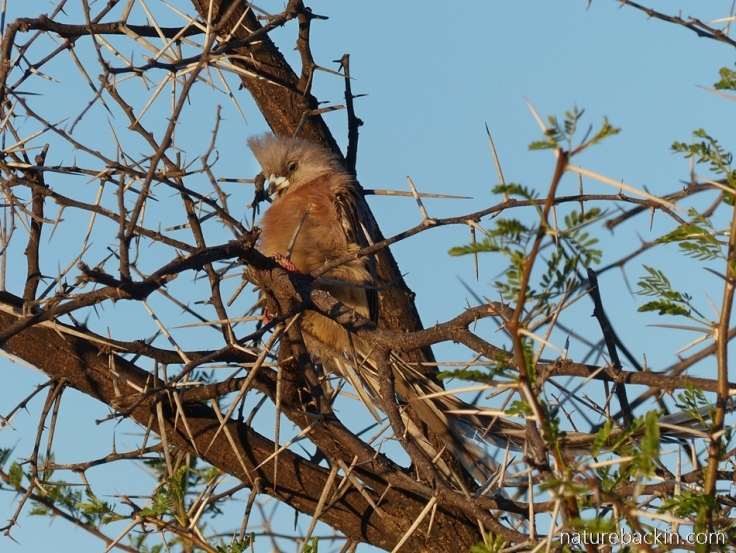
Driving back to camp we stopped to admire this speckled mousebird, one of several preening in the sunshine as they perched in sweet thorn trees next to the road
While at the park we saw several species of antelope in addition to gemsbok and bontebok as already mentioned. We also saw springbok, common duiker, red hartebeest, kudu and black wildebeest (white-tailed gnu). Sadly, the only buffalo we saw was dead. We also saw vervet monkeys, including a troop foraging on the ground more in the fashion of baboons, probably in part because much of the park is devoid of trees other than the sweet thorn.
In the small camp, which has four two-bedded sleeping tents (each with a fridge), a fenced-in (monkey-proof) communal kitchen, communal showers and toilet facilities, several species of birds were very evident. The four-tent camp is called Lakeside Camp, recalling the days when the dam had water. Adjacent is a campsite for visitors equipped with their own tents or caravans. For more on accommodation at Camdeboo National Park see here https://www.sanparks.org/parks/camdeboo/tourism/accommodation.php
Vervet monkeys visited the camp at times. Despite notices warning that food should be kept out of sight, these monkeys were evidently used to being given handouts and equally used to snatching food even from inside tents. While they were around, we kept our food concealed and our tents zipped up. Giving up on us, the monkeys spent time in the camp foraging in trees, and two mothers perched nearby peacefully suckling their small babies.
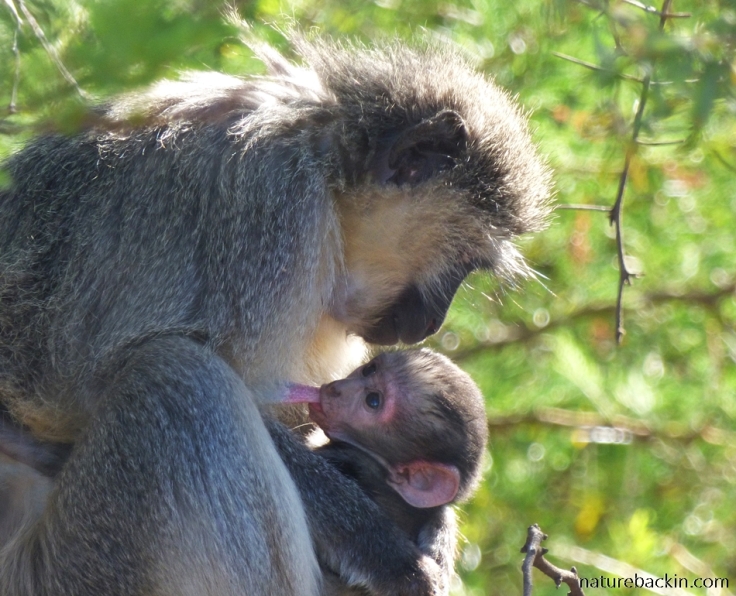
A mother vervet quietly suckling her baby near our tent
However, to our astonishment, when new neighbours arrived in the camp at lunchtime, despite the obvious presence of monkeys, they spread out quantities of food and drink on several portable tables on the deck of their tent. They were seemingly surprised when the monkeys proceeded to help themselves to the food on display. The neighbours then resorted to lots of loud shouting and swearing, while leaving the spread of food enticingly visible.
After all this excitement, the monkeys disappeared from the camp for the afternoon, but late that night for a time we heard the monkeys calling to each other in soft grunts from their night-roosting spots somewhere near the camp. Rather than enjoying the sounds of the wild, the same neighbours yelled at the tops of their voices telling the monkeys to shut-up and f&*#-off. Go figure!
More peacefully, on an unaccountably green small patch of lawn in front of the kitchen, at dusk a scrub hare arrived to feed on the grass. I crept as close as I dared to sit down to watch it, and managed to take a few photos as the light started to fade.
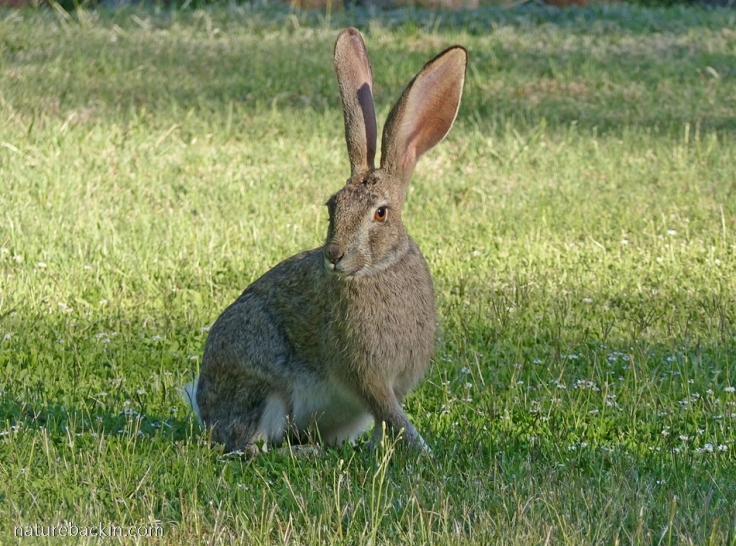
A scrub hare enjoying the patch of green lawn in the camp in evening light. Green grasses are the favourite food of these herbivores

Scrub hares are primarily nocturnal but can emerge to forage at dusk as this one is doing. Until 1912, hares and rabbits were classed as rodents but in fact they have significant differences and they are now classed in the family Leporidae

Scrub hairs live mostly solitary lives. They are endemic to southern Africa
And so ends this post on our visit to Cambedoo National Park. I keep an occasional eye on the region’s weather forecast. Dismally, rain that had been forecast for the coming weekend was no longer on the cards a day or two ago, but checking again today I see that once again there may be a little rain starting this weekend. At best it won’t be much, but it could be something.
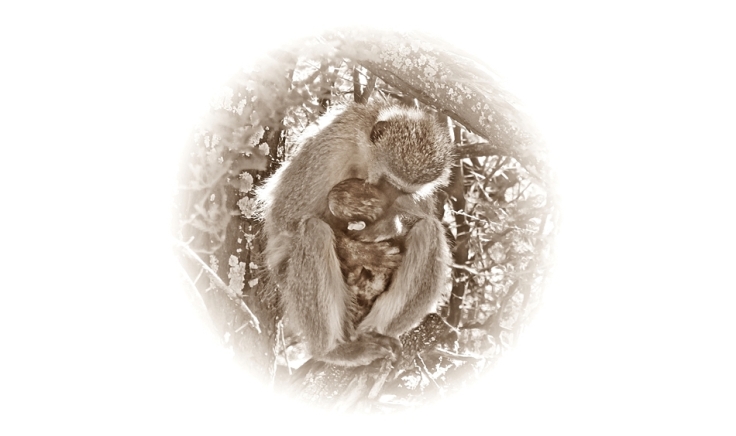
Posted by Carol









January 21, 2020 at 3:24 pm
I worry our global leaders have lost respect for science and empathy for humans and other living creatures. Your photographs and info present the crisis in contrasts of beauty and alarm. You make it accessible.
LikeLiked by 1 person
January 22, 2020 at 7:56 pm
I share the same worry. Evidence-based science has been downgraded to the level of opinion or worse. (I try to avoid making my blog posts into real downers,)
LikeLiked by 1 person
January 22, 2020 at 7:59 pm
You succeed.
LikeLiked by 1 person
January 22, 2020 at 8:17 pm
🙂
LikeLike
January 15, 2020 at 2:27 am
I’m so glad that you could visit Camdeboo, Carol! It is a very special little National Park and if the plans of linking it to Mountain Zebra National Park come to fruition we’ll have another great piece of conserved land to pass on to future generations.
Pity though that some visitors have little respect for the ethos of a National Park…
LikeLiked by 1 person
January 15, 2020 at 8:23 pm
It will be interesting to see if those plans to link the parks come together.
Of course our visit was very much dominated by the dreadful drought. Great that there was some rain in the region last week, although of course the dam remains utterly dry. Hopefully more rains will fall in the coming weeks.
It is too bad when visitors to parks behave inappropriately, although of course many visitors are more sensitive and respectful.
LikeLiked by 1 person
January 1, 2020 at 1:13 am
I am so sorry to read about the drought. When will people ever learn? Posts like these are so important for trying to alert and educate people. Sigh…on another site I follow, there were pics of smoke in Canberra, Australia….On a more upbeat note, your photos made my day. Happy New Year!
LikeLiked by 1 person
January 1, 2020 at 9:03 am
Thank you so much. Yes there is a lot that is sobering, not least the terrifyingly widespread fires in Australia, but we need to find the many reasons to be cheerful as we head into the New Year. Best happy New Year wishes to you too.
LikeLike
December 17, 2019 at 11:56 pm
I have always been fascinated by The Karoo. There was a song in the late 70s ‘ she came from the Karoo’. The rocks are tremendous but I am saddened by the drought but encouraged that there are bore holes for the wildlife. We are almost in drought in our rainy mountains in southern Spain. These are the serious and current effects of a warming climate but there still seems so little connection and action. Whereas here in U.K. we are having too much rain this winter.
LikeLiked by 1 person
December 18, 2019 at 12:20 pm
How interesting about the song! I looked it up and found Tony Bird, whom I had not heard of before. I listened to the few songs I could find but could only find the lyrics to the song referencing the Karoo.
Yes the drought is savage across a huge area, and recent news is that boreholes are running dry, meanwhile elsewhere in the country there have been floods …
Sorry that it is dry in southern Spain too. It is all so sobering and scary and so hard to understand why those who should know better are prepared to sacrifice so much and so many for their short-term gains.
LikeLiked by 1 person
December 18, 2019 at 1:49 pm
That’s, it Tony Bird. What a name! Only the lyrics. What a shame. Think my former husband had the vinyl. Too much short term thinking in politics and especially now. But there is a stronger environmental movement now thanks to Extinction Rebellion and Greta Thunberg among the main new movers.
LikeLike
December 11, 2019 at 5:08 am
That first shot is breathtaking. I simply love jagged rock formations like that (in case you hadn’t noticed?) Seeing so many signs of drought, it’s heart-wrenching to hear of the problems that have been created for humans and critters alike. I watched a video of a woman in Australia rescuing a koala bear from a burning tree. The poor thing just whimpered from the burns. About broke my heart. It’s equally sad to see the creatures in the area you visited suffering from lack of water. I expect there are more than a few places where humans are also in dire need of water. Then there are farmlands here in our “food basket belt” that’s been inundated with so much water that farmers haven’t been able to plant crops. None of it bodes well for the future.
I feel fortunate that we’ve finally had a few inches of rain and there is a prediction of more to come the rest of the week. Things are not looking good, but we can only hope and hang on and do whatever we can or must. My mind simply boggles that too many humans seem to be unaware of any problem.
LikeLiked by 1 person
December 12, 2019 at 12:44 pm
Yes, those rock formations are breathtaking.
I avoided looking at the footage of rescued koalas in the Australian fires. The loss of animal life there must be appalling, in addition to the human deaths that have occurred and the loss of people’s homes and livelihoods. The ongoing anxiety in smoke-filled air must be frightening.
Our drought-stricken areas in SA are in a state of extreme crisis. Even boreholes are now running dry and it is hard to imagine what can be done to alleviate the ongoing emergency over a large area. By contrast there are currently floods and heavy rain in the eastern part of the country. We too have had a lot rain where we live.
I hope that you continue to get more rain but that it does not escalate into too much.
It is hard to understand that so many, including those in leadership, continue to deny the crisis. Even short-term profits can’t explain such bloody-mindedness.
LikeLike
December 14, 2019 at 7:19 am
I can find no explanation for it either… though bloody-mindedness, or greed certainly come to mind.
LikeLiked by 1 person
December 9, 2019 at 9:12 pm
Fascinating post and terrific images, Carol. The drought is frightening and it is sad to see the wildlife struggling. Positive to read about the Cape Zebras. Your story about the annoying campers…I wish the monkeys had stolen all their food! 🙂
LikeLiked by 1 person
December 11, 2019 at 5:10 am
Have to agree with Jane about wishing the monkeys had stolen all their food. People can be such jerks!
LikeLiked by 2 people
December 12, 2019 at 12:44 pm
Indeed 😦
LikeLike
December 7, 2019 at 6:18 am
I like the zebra and scrub hare photos particularly. What a wild and dramatic place, and your photos show how extreme the aridity is. When I read your post I was mulling whether or not I like how my new kitchen faucet delivers my water. One forgets that such thoughts are a luxury in many places in the world including the those in your post. Water, any water, delivered in any kind of way is such a treasure and we so often forget that.
LikeLiked by 1 person
December 7, 2019 at 8:10 pm
We were fortunate to see the zebra, and the scrub hare was unusually tolerant. I guess it had learnt that the camp is a relatively safe place and the patch of green grass was a big draw.
Yes the bigger picture certainly can modulate how one thinks about details, and water is indeed precious. When we have it we tend to overlook that without it nothing is possible. Of course though there is the opposite threat and reality for many of deluges and floods …
LikeLiked by 1 person
December 9, 2019 at 6:27 am
I guess reliable green grass would be a big attraction during a drought. I was reading about floods in Uganda and thinking how unfair life is that one part of Africa has too much water and other parts, not enough.
LikeLiked by 1 person
December 9, 2019 at 1:51 pm
Those floods in the eastern parts of Africa further north of us are horrifying. Even within South Africa we have extremes. It is currently flooding near Johannesburg, while parts of the drought-stricken Eastern and Northern Cape provinces remain in dire straits. I read only today, that in many areas the boreholes are starting to dry up. How will they survive that?
LikeLiked by 1 person
December 10, 2019 at 3:50 am
That’s a big question indeed. These are troubling times we live in.
LikeLiked by 1 person
December 6, 2019 at 12:42 am
Too much, too little…only extremes instead of ‘normal’ weather. We are doing ourselves in.
I pray for reason and action.
LikeLiked by 1 person
December 7, 2019 at 8:00 pm
I really second that – but tragically reason and action seem to be in short supply, especially from those with the power.
LikeLiked by 1 person
December 7, 2019 at 8:31 pm
Yes, the crux of the problem.
LikeLiked by 1 person
December 7, 2019 at 8:33 pm
😦
LikeLiked by 1 person
December 5, 2019 at 8:56 pm
Drought is so hard on the animals, humans included. The landscape is ruggedly beautiful there, let’s hope they see some rain soon.
LikeLiked by 1 person
December 7, 2019 at 7:55 pm
Yes the drought is hard on everyone, even the resilient. Despite all the hardship the landscape is spectacular. We can only hope they get some relief from the ongoing drought soon, although the long-term predictions are not encouraging at this stage.
LikeLike
December 5, 2019 at 6:12 pm
Your photographs of the Scrub Hare are outstanding. I read today that the Eastern Cape has been its driest and hottest for years with no rain of significance in the offing. 2mm here and 5 mm there in soft leaking from the clouds do not even wet under the trees and evaporates quickly in the heat – 38 degrees tomorrow in Grahamstown. You have provided an excellent overview of the precarious situation we find ourselves in.
LikeLiked by 1 person
December 7, 2019 at 7:58 pm
Thanks Anne – that was the tamest scrub hare I have ever seen.
It is bleak, what you describe about the little rain there is evaporating in the high temperatures, and not really wetting the ground at all. I see there is a possibility of some rain for your area in the week ahead, although it might not amount to more than what you describe. Indeed the situation is precarious and the ongoing stress and anxiety must be exhausting.
LikeLike
December 5, 2019 at 6:09 pm
The climate is heading for disaster and so are we. It is a very distressing and alarming situation all over the globe. High time to DO something. Your post is great as usual, and wonderful to hear about the Cape mountain Zebra coming back. And for the rains – let’s hope it is coming, at least some.
LikeLiked by 3 people
December 7, 2019 at 7:52 pm
Distressing and alarming it truly is. Apart from us each doing what we can, hopefully those in power and with the money stop denying the science.
It is good news that the Cape mountain zebra population is increasing.
And as for the rain in the drought stricken areas, we can but hope …
LikeLike
December 9, 2019 at 7:02 pm
Then we hope – for the world.
LikeLiked by 1 person
December 5, 2019 at 5:26 pm
Thank you for taking me back to the Valley of Desolation through your photographs and for inspiring me to revisit the Camdeboo. Your photographs of the animals are enchanting, with such close focus that it felt as if I was looking at the real thing, not an image.
LikeLiked by 1 person
December 7, 2019 at 7:48 pm
I hope that you do get to revisit. It is an amazing place.
I have also been watching the weather forecast in your area, and I see there is a chance of some rain this coming week – I really hope that it happens and doesn’t end in disappointment yet again. Even a little will be welcome.
LikeLike
December 7, 2019 at 8:16 pm
Thanks for the rain thoughts and wishes
LikeLiked by 1 person
December 5, 2019 at 4:56 pm
Despite the stark beauty of this region, the situation you describe is worrying and unsustainable. Nobody, apparently, has the weather they expect or need. We have too much water, you too little. And what extraordinary camp neighbours you had!
LikeLiked by 1 person
December 5, 2019 at 5:16 pm
Indeed, such extremes are worrying in so many regions. Here in the eastern part of SA, we are at this moment in time relatively lucky. We have had some rain (unfortunately enough to cause floods and destruction in some areas) and although the water table remains low, at least our local reservoirs are okayish at least for now. The situation in the Eastern Cape and other drought areas is a prolonged catastrophe.
And there you are with too much water. We can only wish for moderation – and not only in the weather 😦
And our camp neighbours could have done with being a bit more moderate too …
LikeLiked by 1 person